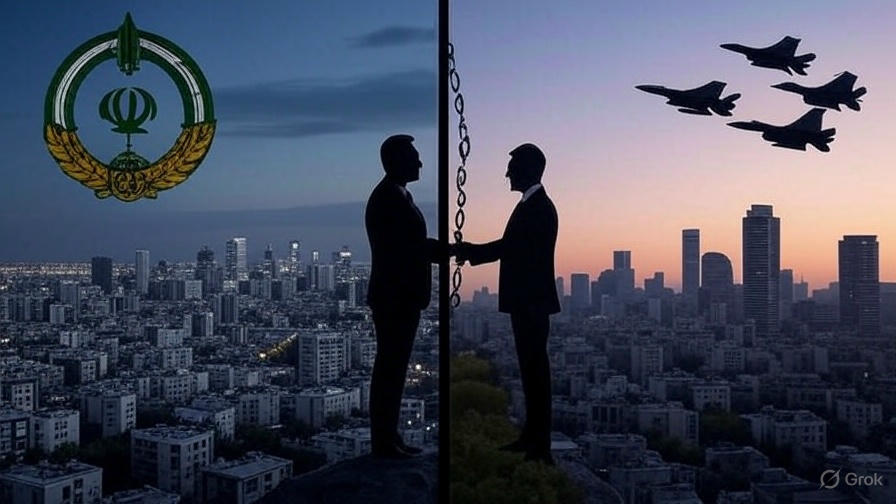In recent geopolitical developments, the Iran-Israel conflict has once again taken center stage, drawing in global powers like the United States , regional actors such as Arab countries , and even non-Middle Eastern players like India . This evolving crisis not only highlights the volatile nature of the Middle East but also underscores the complex interplay between military strategy , diplomacy , and intelligence operations . What began as a high-stakes confrontation appears to have concluded with a strategic ceasefire , brokered indirectly by former U.S. President Donald Trump . Yet, beneath the surface, the implications for U.S. foreign policy , Iran’s nuclear ambitions , and the broader regional balance of power remain profound.
Table of Contents
A Pre-Planned Escalation or a Calculated Ceasefire?
Analysts suggest that the latest round of hostilities was not a spontaneous military clash but rather a calculated move by both Iran and the United States to de-escalate tensions through controlled escalation. According to reports, Iran launched missile strikes on U.S. bases in Qatar after securing prior understanding from Washington. This carefully orchestrated act served multiple purposes — allowing Iran to demonstrate strength domestically, placate internal dissent, and yet avoid full-scale war.

Former U.S. President Donald Trump later confirmed this tacit agreement, stating that Iran had communicated its intentions beforehand and that the strikes were carried out with American consent. The missiles fired by Iran were intercepted or allowed to land in uninhabited areas, minimizing damage. This maneuver effectively opened the door for a ceasefire , which was ultimately announced within 24 hours.
This incident raises an important question: Was this a “fixed match” designed to manage regional tensions without triggering wider war?
The Role of the United States: Balancing Interests and Managing Outcomes
The U.S. position throughout this conflict has been one of cautious engagement. While maintaining strong ties with Israel , Washington also sought to avoid a direct confrontation with Iran . The deployment of B-2 bombers and other military assets was more symbolic than operational, serving as a deterrent rather than a precursor to all-out war.
Trump’s diplomatic intervention played a pivotal role in ending the hostilities. He congratulated both Iran and Israel equally for agreeing to the ceasefire, signaling a shift in U.S. policy toward the region. His tweet — “God Bless Iran ” — marked a surprising softening of tone from a country long seen as hostile to Iranian interests.
This change in rhetoric reflects a deeper recalibration of U.S. foreign policy. Instead of pushing for regime change , Washington now seems more inclined toward containment and strategic engagement , particularly as it becomes increasingly clear that destabilizing Iran could lead to far greater chaos across the Middle East .
Military Performance Audit: How Effective Were the Missiles?
While both sides declared victory, a closer examination of the military performance audit reveals mixed outcomes. Iran launched over a dozen missiles at U.S. facilities in Qatar, but most were either intercepted or landed harmlessly. Israel’s advanced Iron Dome system also demonstrated its effectiveness, mitigating much of the potential destruction.
However, questions remain about the efficacy of Iran’s missile program . Despite launching numerous strikes, the level of damage inflicted on Israeli infrastructure was minimal. Many missiles were intercepted mid-air, raising concerns about the accuracy and reliability of Iran’s military capabilities.
On the flip side, Iran successfully preserved its 400 kilograms of enriched uranium , a critical component of its nuclear program. From Tehran’s perspective, this was a significant achievement — proving that its core strategic assets remained intact despite intense pressure from the West.
Thus, while neither side achieved a decisive military advantage, both managed to claim strategic success — a hallmark of modern asymmetric warfare.
Domestic Resilience vs. International Isolation
One of the most striking contrasts during the conflict was the domestic resilience shown by Iranian society versus the fractured unity in Israel . In Iran, mass gatherings continued unabated, with citizens showing unwavering support for their government’s stance. Friday prayers drew thousands, and public morale remained high.
In contrast, Israel experienced visible signs of public unrest. Citizens fled urban centers, and local mayors called for an end to hostilities. This divergence in public sentiment suggests that while Israel remains militarily strong , its civilian cohesion under pressure is fragile .
From a comparative analysis, it becomes evident that Iran’s population is more unified in times of conflict , whereas Israeli society shows signs of fragmentation when faced with prolonged threats . This dynamic could influence future strategies, especially if conflicts become drawn out or more frequent.
Regime Change or Strategic Stability?
The idea of regime change in Iran has long been a talking point among Western policymakers and Israeli leaders. However, the recent conflict has underscored how difficult — if not impossible — such a goal might be. Supreme Leader Ayatollah Ali Khamenei , though reportedly retreating to a bunker, maintained firm control over the state apparatus. His authority remained unchallenged, even as external pressures mounted.
Moreover, attempts to destabilize Iran internally — whether through covert operations or intelligence infiltration — have met with limited success. While Mossad has made inroads inside Iran, particularly in targeting key figures like the leader of Hamas , these efforts have not significantly weakened the regime.
Strategically, any attempt at regime change would require ground forces , something the U.S. and its allies are unwilling to deploy. Without boots on the ground, covert operations alone cannot topple a resilient regime , especially one backed by a mobilized population.
India’s Position: A Shifting Geopolitical Stance
India’s alignment with Israel during the conflict did not go unnoticed. New Delhi’s firm pro-Israel stance has raised questions about its traditionally neutral foreign policy. This shift could have serious implications for India-Iran relations , particularly concerning energy cooperation and access to strategic ports like Chabahar .
Furthermore, India’s use of RAW (Research and Analysis Wing) networks to destabilize Iran via Baloch separatists has long been a source of tension. With Iran now intensifying efforts to dismantle Mossad’s network , there are growing concerns about how this will affect Indian intelligence activities in the region.
If Iran decides to recalibrate its relationship with India due to its perceived alignment with adversaries, Pakistan stands to benefit. Already, Islamabad and Tehran have found common ground in multilateral forums like the OIC , suggesting a potential realignment of regional alliances.
Intelligence Networks and Covert Warfare
The role of intelligence networks — particularly Mossad — cannot be overstated. Israel’s ability to conduct targeted assassinations deep inside Iran, including the killing of top scientists and military officials, demonstrates the depth of its penetration. However, these successes have come at a cost, prompting Iran to crack down hard on suspected spies.
Recent reports indicate that Iran has executed several individuals linked to Mossad, sending a clear message that internal security remains a top priority. These actions also reflect Iran’s growing awareness of vulnerabilities within its own ranks, especially in sectors related to defense and nuclear research.
For Mossad, the challenge lies in maintaining operational capacity amid heightened surveillance and counterintelligence measures. As Iran strengthens its domestic defenses, the space for foreign espionage shrinks, forcing agencies like Mossad to rely more on cyber operations and satellite reconnaissance.
Diplomatic Shifts in the Middle East
Despite the conflict, there are signs of a broader diplomatic thaw. Arab countries, many of which have recently normalized relations with Israel, appear to be seeking a balanced approach. Nations like Qatar , which hosted the missile strike, played a crucial role in mediating peace talks.
Meanwhile, Iran has signaled openness to dialogue, cooperating with OIC member states and engaging in backchannel diplomacy. This suggests that while military posturing continues, diplomacy remains a viable path forward .
The U.S., too, has shifted its tone. After years of sanctions and isolation, Washington now seems open to re-engagement with Tehran — albeit cautiously. If this trend continues, we may see a gradual lifting of sanctions and a return to some form of nuclear deal , possibly even broader economic cooperation.
Conclusion: Toward a New Middle East Order
The Iran-Israel conflict, though brief, offers valuable insights into the evolving dynamics of Middle Eastern geopolitics . It highlights the limits of military force, the importance of intelligence operations , and the enduring relevance of diplomacy in resolving disputes.
As the dust settles, several key themes emerge:
- The U.S. is shifting from regime change to containment .
- Iran has proven resilient , both militarily and politically.
- Israel faces internal challenges despite its military superiority.
- India’s alignment with Israel could impact its relationship with Iran.
- Mossad’s presence in Iran remains active , but under increasing scrutiny.
- Arab countries are playing a mediating role , signaling a new era of regional diplomacy.
Ultimately, the conflict underscores the complexity of managing rivalries in a region where history, ideology, and power intersect in unpredictable ways. While a full-scale war was avoided, the underlying tensions remain unresolved. Whether this fragile peace holds will depend on the willingness of all parties to engage in sustained dialogue — and perhaps, on the next move by Donald Trump.
Resources Internal/External Links
Internal: News | External: Learn More
1. Council on Foreign Relations (CFR) – Iran’s Foreign Policy
Link: https://www.cfr.org/backgrounder/irans-foreign-policy
2. Al Jazeera – Middle East News & Analysis
Link: https://www.aljazeera.com/middle-east/
3. The Diplomat – India-Iran Relations and Regional Security
Link: https://thediplomat.com/tag/india-iran-relations/
Frequently Asked Questions:
Q1: What was the Iran-Israel conflict about?
A1: The conflict involved a series of strategic military actions and diplomatic maneuvers, primarily between Iran and Israel, with the United States playing a key mediating role. It centered around regional security, nuclear ambitions, and intelligence operations.
Q2: Was the conflict pre-planned or spontaneous?
A2: Analysts suggest it was a controlled escalation—a “fixed match”—where both Iran and the U.S. agreed on limiting the scope of hostilities to avoid full-scale war while achieving strategic goals.
Q3: How did Donald Trump influence the ceasefire?
A3: Former President Donald Trump played a pivotal role in brokering the ceasefire, congratulating both sides and signaling a shift in U.S. policy toward containment rather than confrontation.
Q4: Did Iran’s missile attacks achieve their goal?
A4: While Iran launched multiple missiles, many were intercepted. However, it preserved its 400 kg of enriched uranium, which Tehran viewed as a strategic success.
Q5: How did public sentiment differ between Iran and Israel during the conflict?
A5: Iran showed strong domestic unity and resilience, whereas Israeli society exhibited signs of fragmentation, with citizens fleeing urban centers and mayors calling for an end to hostilities.
Q6: Was regime change in Iran a possibility?
A6: Despite Western hopes, regime change remains unlikely without internal support and ground forces—both of which were absent during this conflict.
Q7: What is the role of intelligence networks like Mossad?
A7: Mossad has maintained a strong presence inside Iran, conducting targeted assassinations and sabotage. However, Iran has intensified counterintelligence efforts to dismantle these networks.
Q8: How did India’s stance affect its relationship with Iran?
A8: India’s pro-Israel stance raised concerns in Tehran, potentially affecting bilateral cooperation, especially regarding RAW’s alleged activities against Pakistan in Iran.
Q9: Will there be improved U.S.-Iran relations after this conflict?
A9: There are indications of a potential thaw, including softer U.S. rhetoric and backchannel diplomacy, suggesting that engagement—not confrontation—may be the new direction.
Q10: What does the future hold for Middle East stability?
A10: While immediate hostilities ended, underlying tensions remain unresolved. Diplomacy and sustained dialogue will be crucial in maintaining peace and preventing future escalations.

